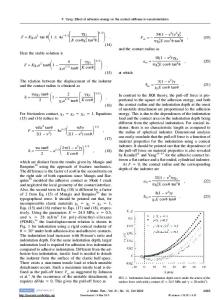A note on the elastic contact stiffness of a layered medium
- PDF / 301,396 Bytes
- 4 Pages / 576 x 792 pts Page_size
- 29 Downloads / 372 Views
Tsai-Wei Wu IBM Research Division, Almaden Research Center, San Jose, California 95120-6099 (Received 24 May 1993; accepted 4 August 1993)
A perturbation method is used to confirm that the elastic contact stiffness associated with a flat-ended punch indenting a layered medium is insensitive to the cross-section shape of the punch as long as the shape does not differ too much from a circle. This result supports the practice of modeling nonaxisymmetric indenters such as Vickers or Berkovich indenters as an axisymmetric flat-ended cylindrical punch.
I. INTRODUCTION Microindentation techniques are frequently used to study mechanical properties of thin film coatings on substrate.1^5 In addition to the hardness test, a microindenter can also be designed to perform different types of testing such as indentation fatigue, load relaxation, microscratch, and wear via different operating modes.7 In using indentation to measure elastic properties, it is often assumed that the elastic modulus can be linearly related to the initial slope of the load-displacement curve during unloading, i.e., the contact stiffness during initial withdrawal of the indenter. Commonly used Vickers or Berkovich indenter tips are square-based or triangularbased pyramids. An exact analysis of these geometries usually requires numerical computations.8 On the other hand, it is also desirable and convenient to have simple analytical formulas for reasonable approximations. The initial unloading behavior of an indenter is often approximated as a flat-ended cylindrical punch since the contact area remains nearly constant. To justify this practice, Pharr et al.9 recently made use of Sneddon's 10 analysis for the elastic contact between a rigid, axisymmetric punch and an elastic half space and showed that the flat-punch-behavior is valid for any indenter geometry as long as the indenter is a body of revolution. On the other hand, numerical results of King8 for flat-ended punches with circular, triangular, and square cross sections further suggested that the contact stiffness should also be insensitive to the cross-section shape of the punch. We are interested in examining this indenter-shape-insensitivity issue from a different perspective. In this paper, a perturbation method is used to verify that the elastic contact stiffness of a general layered medium is indeed approximately independent of the cross-section shape of the flat punch as long as the shape does not differ too much from a circle.
II. A FLAT RIGID PUNCH INDENTING A LAYERED MEDIUM Figure 1 depicts a flat-ended rigid punch indenting a layered elastic half space. Such a punch has been used to model the behavior of Berkovich and Vickers indenter tips with triangular or square bases, as shown in Fig. 2. A simplification is to replace the actual crosssection shape of the indenter by a matching circle with the same cross-section area. In general, a given crosssection geometry can be described by a polar function r = a{6) so that the radius of the matching circle is given by (Fig. 3)
ira2mc = l["a2(e
Data Loading...











